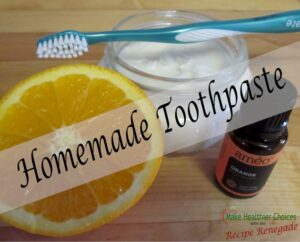No More Plaque
Ralph Nadar exposed the Dirty Dozen in Cancer Prevention News, in the Fall 1995 issue. The toothpaste I used at the time, Crest Tartar Control, happened to be on that list. I quickly moved to better, more trusted toothpastes. I have only used homemade toothpaste for a few years. I’m glad I switched!
I’ll admit my surprise when my dental hygienist said, “you no longer have plaque on your teeth.” She also said, “you only have stain from drinking coffee or tea.” Then she asked, “Are you using baking soda?” I actually thought to myself, hmmm…it must be well-known at least in the dental community, that baking soda removes plaque, and Wow, if I gave up coffee, tea, and any stain-causing drinks, what would she do during my appointment?
Too Sloppy or Too Hard?
If you’ve ever made your own toothpaste, you know it’s usually too sloppy in the summer and too hard in the winter. I had to experiment to keep my toothpaste softer in the winter and more solid in the summer. Coconut oil is solid at 76° and stays liquid above that temperature. Coconut oil and orange essential oil are both known teeth whiteners.
The Right Consistency
My secrets to keeping the right consistency: In winter, I add fractionated coconut oil (FCO) or MOM (Milk of Magnesia) In the summer, I omit the FCO and add more baking soda. I keep adding baking soda until it’s the consistency I want. To make adjustments in temperatures under 76°, it needs to be heated until melted or added to a food processor (I use this mini-processor). I sometimes use a bigger processor to make more at once. Since we all keep our homes at different temperatures, we’ll all use different amounts of FCO and baking soda. Start with my basic recipe and go from there—adding either more FCO, MOM, or more baking soda.
Each Family Member Should Have Their Own Jar
You’ll need to dip your toothbrush into the jar. Please give each family member a jar of their own toothpaste. It’s not a good idea to spit this toothpaste out into your sink. CAUTION: Coconut oil is great at clogging drains. I always use organic coconut oil as my base, but for making do-it-yourself recipes like this one, I sometimes use the lesser expensive, organic refined coconut oil.
UPDATE
UPDATE: At my most recent cleaning appointment in March 2016, I again asked if I had any plaque. My hygienist said, “No, only stain from coffee.” She suggested I use a whitening mouth rinse and then added “they contain hydrogen peroxide.” Of course, I won’t use chemical-laden mouth washes. I typically had a cavity every one to two years, but I’ve not had a cavity in the six years I’ve been drinking Zija International’s Supermix which is primarily moringa oleifera (a plant). Zija International was the company that brought moringa to the United States in an enzymatically alive, bioavailable, easy-to-re-hydrate packet. Zija has since been purchased by Isagenix. You can find it here: Isagenix Zija Supermix.
Please note: This is my experience; you might not have the same results.

I’ve only been using this toothpaste for two weeks and my teeth feel so much cleaner. Easy to make.
Ever since my dentist told me that I could try making my own toothpaste because I don’t like to use unnatural ingredients, I have tried many different recipes. However, it has been pretty difficult for me to find a toothpaste that has a good consistency. What I think is unique about your recipe is that you have used two different types of coconut oil and so I am intrigued to know how that will affect the texture and consistency. However, is it absolutely necessary for me to use orange essential oil or could I use another type instead?
Thanks for asking this question, Faylinn. I’ve only ever used Peppermint Oil or Orange Oil, but I would think almost any oil that is safe to ingest or that is proven safe for mucous membranes would be okay to use for toothpaste. Make sure you first check with your dentist. Be certain to only use an essential oil that is guaranteed to be pure, like Améo.